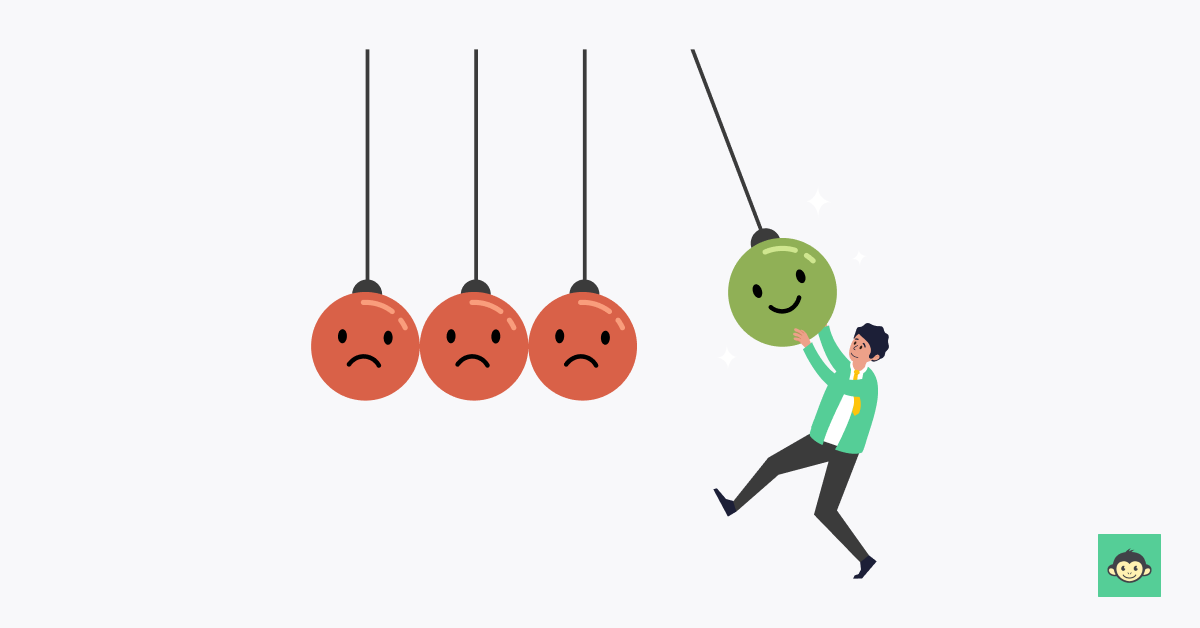What is peer feedback: Definition, examples, and top tips

Feedback isn't just a courtesy; it's a catalyst for growth. Peer Feedback stands at the forefront, a powerful tool that leverages the collective wisdom of colleagues to fuel individual and team development.
Peer feedback is more than just a trendy term. It's a practice grounded in results, with an article revealing that experts believe peer feedback and peer coaching are key drivers of human capital development. Its importance cannot be overstated - it nurtures collaboration, enhances performance, and fosters a culture of continuous improvement to make sure everyone's on the same page.
In this blog, we'll explore the depths of peer feedback, dive into real-world examples, and equip you with top-notch tips to harness the power of collective insight for individual and collective growth.
What is peer feedback?

Peer feedback is a process where employees provide constructive input, based on their observations and interactions, with their colleagues. This feedback can encompass various aspects of an individual's performance, such as behavior, communication skills, and contributions to team dynamics. Peer feedback typically aims to offer valuable insights, promote personal growth, and enhance teamwork within an organization.
It often involves both positive and constructive criticism, fostering a culture of continuous improvement. This approach helps employees gain a better understanding of their strengths and areas needing development, ultimately contributing to their professional development and the overall success of the organization. Peer feedback is an essential component of a 360-degree feedback system, offering a holistic view of an individual's performance.
What are the different types of peer review feedback?

Peer review feedback can take various forms, tailored to specific goals and contexts within an organization. Here are different types of peer review feedback:
Formative feedback
This type of feedback occurs during a project's development, allowing peers to offer suggestions and improvements to enhance the ongoing work. It focuses on helping the individual or team to refine their efforts.
Summative feedback
Summative feedback is usually given at the end of a project or task. It evaluates the overall performance and outcome. It can be used for decision-making, promotions, or performance appraisals.
Constructive feedback
Constructive feedback is aimed at identifying areas for improvement. It highlights weaknesses but offers specific suggestions for enhancement, promoting professional growth.
Positive feedback
Positive feedback emphasizes strengths and achievements. It recognizes and reinforces excellent performance and behavior to boost motivation and confidence.
360-degree feedback
This comprehensive approach gathers feedback from multiple sources, including peers, managers, subordinates, and self-assessments. It provides a well-rounded view of an individual's performance.
Anonymized feedback
Some organizations opt for anonymity in peer reviews to encourage honest and unbiased feedback. This can lead to more candid insights.
Qualitative and quantitative feedback
Feedback can be qualitative (descriptive) or quantitative (measured). Qualitative feedback provides narrative comments, while quantitative feedback may involve rating scales or numerical assessments.
Continuous feedback
Rather than waiting for scheduled annual performance reviews, continuous feedback is provided regularly, enabling immediate course correction and improvement.
Project-specific feedback
Feedback is directed toward specific projects or tasks, addressing performance within the context of particular assignments.
General performance feedback
This type assesses overall performance, typically within a specific time frame, and can cover various aspects of an individual's role and responsibilities.
Real-time feedback
Real-time feedback is given immediately after a task or behavior. It allows employees to make quick adjustments and improve performance without waiting for formal reviews.
Developmental feedback
Developmental feedback focuses on long-term growth by guiding peers in skill-building and career development, offering recommendations for future goals.
Milestone feedback
Milestone feedback is provided at key stages of a project, offering insights to track progress and refine approaches at important points. Giving peer feedback at these moments ensures the team stays aligned with goals.
The choice of feedback type depends on the organization's objectives, the nature of the work, and the desired outcomes of the peer review process. Different types of feedback can be used in combination to provide a comprehensive understanding of an individual's performance.
Why is peer review important?

Peer review is essential in various contexts, including academia, research, and the workplace, for several compelling reasons:
- Quality assurance: Peer review ensures the quality and credibility of work. Peers evaluate the accuracy, validity, and integrity of research, projects, or reports, enhancing overall standards.
- Error detection: Peers can identify errors, flaws, or biases that may be overlooked by the author. This helps prevent inaccurate information from circulating and maintains the integrity of the work.
- Knowledge validation: Peer review validates the knowledge and findings presented. This is particularly important in scientific research, where peer-reviewed studies are considered more reliable and trustworthy.
- Diverse perspectives: Peer reviewers come from diverse backgrounds and experiences. Their feedback offers different viewpoints, leading to a more well-rounded, comprehensive, and inclusive outcome.
- Skill development: For employees, peer reviews can be valuable for skill development. Constructive criticism from peers helps individuals recognize areas for improvement and grow professionally.
- Accountability: Knowing that their work will be reviewed by peers encourages individuals to take their responsibilities seriously, fostering a culture of accountability.
- Decision-making: In organizations, peer review can influence decisions related to promotions, pay raises, and project assignments. It ensures that decisions are fair, based on merit and contribute to a positive work environment.
- Continuous improvement: Regular peer feedback encourages continuous improvement. It allows individuals and teams to refine their work over time, striving for excellence.
- Knowledge sharing: Peer review promotes knowledge sharing within a group or community. It facilitates the dissemination of best practices and lessons learned.
- Conflict resolution: Peer review can help address conflicts or disagreements within a team. It provides a structured process for discussing issues and finding solutions.
- Professional growth: Constructive criticism from peers contributes to an individual's professional growth. It encourages learning and skill enhancement.
- Credibility: Peer-reviewed publications, whether in research or other domains, enhance an individual's or organization's credibility and reputation.
Peer review plays a pivotal role in maintaining standards, fostering collaboration, and promoting growth and accountability. Whether in academia, research, or the workplace, it serves as a crucial mechanism for ensuring the quality and integrity of work while supporting individual and collective development.
What is a good example of peer feedback?

A good example of peer feedback should be constructive, specific, and focused on growth and improvement. Here are such peer review examples :
Positive feedback
"John, I wanted to let you know that I was impressed with your presentation during our team meeting yesterday. Your slides were clear, and you spoke confidently. It made the topic much easier to understand, and your enthusiasm was contagious. Great job!"
Constructive feedback
"Susan, I noticed during our last project that sometimes your communication with the team was a bit unclear. Specifically, there were a few instances where our roles and responsibilities weren't entirely clear, which caused some confusion. To improve, maybe we could set clearer expectations at the beginning of our next project."
This example demonstrates the elements of effective peer feedback:
Balanced approach: It begins with positive feedback to highlight strengths and achievements, making the recipient more receptive to constructive feedback.
Specificity: Both positive and constructive feedback are specific. They point out exactly what was done well or what needs improvement.
Actionable suggestions: Constructive feedback includes actionable suggestions for improvement, such as setting clearer expectations in this case.
Respectful tone: The feedback is delivered respectfully, focusing on behaviors or actions rather than making personal judgments.
Encouragement: Positive feedback includes words of encouragement or praise, which motivates the recipient.
Openness to dialogue: Feedback should invite further discussion, where the recipient can ask for clarification or discuss strategies for improvement.
The goal of peer feedback is to support growth and development, so it should always be delivered with the recipient's best interests in mind, promoting a culture of continuous improvement and collaboration.
How to use peer feedback examples to improve the evaluation process?
Peer feedback examples are a valuable resource that can be leveraged to enhance the evaluation process. They offer practical insights and set clear expectations, making feedback more actionable and impactful.
- Use examples to set benchmarks: Incorporating peer feedback examples helps establish clear benchmarks for performance. They provide concrete instances of desired behaviors, making it easier to assess future performance consistently.
- Encourage specific, targeted feedback: Sharing examples guides team members on how to give more specific feedback. By illustrating effective feedback, it helps avoid vague comments and fosters more constructive and detailed insights.
- Create templates for feedback: Develop templates based on peer feedback examples to standardize the evaluation process. This ensures consistency across the board and makes it easier for colleagues to provide relevant, structured feedback.
- Highlight both strengths and areas for improvement: Examples that balance positive and constructive feedback encourage evaluators to take a holistic approach. It ensures that peers not only address areas for improvement but also recognize strengths, promoting a growth-oriented mindset.
- Promote dialogue and reflection: Using examples in peer feedback encourages recipients to reflect on their own performance. It opens the door for discussions, helping peers engage more deeply with the feedback and make necessary adjustments.
- Enhance training for evaluators: By using feedback examples during training sessions, organizations can improve evaluators' skills. This helps them provide clearer, more actionable feedback, ultimately refining the overall evaluation process.
How do you give quality peer feedback?

Giving peer review feedback is crucial for fostering growth and improvement in the workplace. Here are some steps to give effective peer feedback:
- Be specific: Avoid vague statements. Instead of saying, "You did a good job," say, "I appreciate how you met the deadline, which helped us stay on track."
- Balance positive and constructive feedback: Start with positive feedback to create a receptive atmosphere. Then, provide constructive feedback to address areas for improvement.
- Use "I" statements: Express your thoughts and observations using "I" statements. For example, say, "I noticed that..." rather than "You always..."
- Be timely: Give feedback as soon as possible after the observed behavior or action. This makes it more relevant and actionable.
- Focus on behavior, not personality: Avoid making judgments about a person's character. Instead, comment on specific actions or behaviors.
- Offer solutions: When giving constructive feedback, suggest practical solutions or alternatives to help the individual improve.
- Ask open-ended questions: Encourage a dialogue by asking questions like, "How do you think this could be improved?" This invites the recipient to reflect and engage in problem-solving.
- Be respectful and courteous: Maintain a respectful tone and avoid sounding judgmental or confrontational.
- Use examples: Provide concrete examples to illustrate your feedback. This makes it easier for the recipient to understand and act upon.
- Follow-up: After giving feedback, check in with the person to see how they are progressing. This demonstrates your commitment to their development.
- Be mindful of cultural differences: Recognize that cultural norms may influence how feedback is given and received. Adapt your approach as needed.
- Practice active listening: If the recipient responds or has questions, listen actively and be open to their perspective.
- Seek permission: If the feedback is unsolicited, ask if the person is open to receiving feedback before providing it.
Remember that the purpose of peer feedback is to support growth and development, not to criticize or judge. When given thoughtfully and constructively, it can contribute to a more positive and productive work environment.
How do you give peer review feedback to remote teams?
Providing effective peer review feedback to remote teams can foster connection and boost team performance, despite the distance. Even in remote settings, maintaining a collaborative environment through peer feedback is essential for team success and cohesion Here are some strategies to ensure your feedback is impactful and well-received:
- Schedule regular, meaningful feedback sessions : Establish a consistent schedule for peer review feedback, such as weekly or monthly check-ins. This ensures that peer review feedback remains timely and relevant, and creates a routine to provide valuable insights to remote teams.
- Use video calls for personal touch: Whenever possible, deliver feedback via video calls. Seeing facial expressions and hearing tone adds nuance that can be lost in written communication, making feedback feel more personal and constructive.
- Be mindful of time zones: Remote teams often work across different time zones, so be considerate of when you're delivering feedback. Ensure that the timing works for both parties, allowing for real-time discussions when possible.
- Leverage collaborative tools: Use tools like Google Docs or project management platforms to provide clear, documented feedback. This allows for transparency and provides a written record that team members can refer back to.
- Encourage open-ended discussions: Rather than one-sided feedback, ask open-ended questions that invite dialogue, such as, "How do you think this approach could be improved?" This promotes collaboration and allows remote workers to share their perspectives.
- Focus on outcomes, not just tasks: In remote teams, it's essential to emphasize the overall impact of work rather than only task completion. Highlight how a peer’s contribution affects team goals and project outcomes to foster a sense of purpose and alignment.
What is an example of constructive feedback in peer review?

Situation
During a team project, a colleague was responsible for creating a presentation. The presentation had some issues.
Constructive feedback
"I appreciate your effort in creating the presentation. However, I noticed a few areas where it could be improved:
Clarity: The main points were somewhat buried in the middle. It might be more effective if you start with a clear introduction of our key message.
Visuals: The charts were helpful, but they could be more visually appealing with some color and labels for clarity.
Engagement: To keep the audience engaged, consider adding a few real-world examples or anecdotes related to our topic.
Timing: During our practice run, I noticed it was slightly over the allotted time. Let's work together to trim it down to meet the time constraints.
I believe these adjustments will make our presentation even more impactful. Would you like to discuss this further, or do you have any suggestions on how to implement these changes?"
This example demonstrates constructive feedback by acknowledging the effort, being specific about the issues, offering solutions, and inviting a collaborative discussion for improvement.
10 Negative peer feedback examples

Constructive peer feedback is essential for personal and professional growth, but sometimes it can be challenging to deliver or receive. Here are ten examples of negative peer feedback along with explanations of why they should be avoided:
- Personal attacks: Feedback like, "You're lazy," or "You don't care about your work," is not constructive. It's essential to focus on behaviors and actions, not make personal judgments.
- Vagueness: Feedback that lacks specificity, such as, "Your work needs improvement," is unhelpful. Specifics allow the recipient to understand what exactly needs to change.
- Comparisons: Comparing a colleague negatively to others, like saying, "You're not as good as [another colleague]," can be demotivating and harm team dynamics. It's better to focus on individual improvement.
- Overwhelming critique: Providing an exhaustive list of flaws without acknowledging strengths can demoralize and overwhelm the recipient. Balance is key to effective feedback.
- Ignoring effort: Disregarding the effort someone put into a task and solely focusing on the result can be demoralizing. It's important to recognize and appreciate hard work even if the outcome falls short.
- Ignoring growth: Failing to acknowledge improvements or changes made since previous feedback can be demotivating. Recognizing growth encourages continued progress.
- Failure to listen: Dismissing or not addressing concerns raised by the recipient regarding the feedback can damage trust. Effective feedback is a two-way conversation.
- Blame without solutions: Saying, "You messed up the project," offers no guidance. Blame alone creates resentment and doesn't encourage improvement. Instead, provide actionable steps for correction.
- Overgeneralizing: Statements like, "You never contribute to meetings," are vague and feel unfair. Broad claims make it hard to identify specific areas for improvement. Focus on particular instances instead.
- Dwelling on past mistakes: Comments like, "You always make the same mistake," focus on failures and discourage progress. Feedback should address current efforts and future improvements.
Negative feedback can still be constructive when delivered with care and consideration. Instead of employing these negative approaches, it's better to focus on specific, actionable, and respectful feedback. For instance, if someone's work needs improvement, you could say, "I noticed some errors in the report. It would be helpful to double-check calculations and proofread before finalizing."
Ultimately, the goal of peer feedback is growth and improvement, so maintaining a constructive and empathetic tone is crucial for its effectiveness.
How do you write a peer review: Do's & don'ts for giving feedback to peers?

Peer reviews are essential for fostering growth, learning, and collaboration within a team or organization. To provide effective feedback to peers, it's important to follow certain do's and don'ts:
Do's:
- Be precise: Offer detailed, specific examples to illustrate your points. This helps the recipient understand what they did well or need to improve.
- Be constructive: Focus on actionable suggestions for improvement rather than criticism. Use phrases like, "Consider trying..." or "You might find it helpful to..."
- Balance positives and negatives: Highlight both strengths and areas for improvement. Recognize what they did right before suggesting changes.
- Be timely: Provide more feedback promptly while the task or project is still fresh in everyone's mind. This makes it more relevant and actionable.
- Do direct communication: Express your observations and opinions using phrases like "I noticed" or "I think." This avoids sounding judgmental or accusatory.
- Empathize: Understand that your peer may have reasons for their choices. Ask questions to gain insight into their perspective before providing feedback.
Don'ts:
- Don't be vague: Avoid generic comments like "good job" or "needs improvement." These don't provide any actionable guidance.
- Don't attack personally: Never use personal attacks, insults, or offensive language. Feedback should be about actions and behaviors, not the individual.
- Don't make assumptions: Base your feedback on facts and observed behaviors, not assumptions or rumors.
- Avoid overloading: Don't overwhelm your peers with too much feedback at once. Focus on a few key points for improvement.
- Avoid recency bias: Don't let one recent incident overshadow a person's overall performance. Consider their entire body of work.
- Don't use sarcasm or irony: These forms of communication can easily be misinterpreted and may lead to misunderstandings.
- Don't forget to offer praise: Even when addressing areas for improvement, don't forget to acknowledge and praise your peer's strengths and accomplishments.
- Don't disregard privacy: Respect confidentiality and privacy. Don't share sensitive or personal information in your feedback.
- Don't rush: Take your time to provide thoughtful feedback. Rushed feedback can be less effective and may come across as insincere.
- Don't be biased: Guard against biases related to gender, race, or personal preferences. Base your feedback on objective criteria.
The goal of peer reviews is to help each other grow and succeed. Following these do's and don'ts ensures that your feedback is constructive, respectful, and ultimately beneficial for your peers and your team members.
Conclusion
Peer feedback is not about criticism; it's about support and development. It is a powerful tool that can drive personal and professional growth within any organization. When individuals in a team engage in meaningful, respectful, and timely feedback exchanges, the entire organization benefits. It leads to enhanced teamwork skills, increased self-awareness, and a culture of continuous improvement.
So, whether you're offering praise for a job well done, or gently pointing out areas for growth, remember that peer feedback is a valuable tool for personal and collective success.
FAQs
What exactly is peer feedback, and how does it differ from other types of feedback?
Peer feedback is a process in which colleagues, typically at the same professional level, provide constructive input to one another based on observations of their work-related behavior, skills, or performance. Unlike feedback from supervisors or managers, peer feedback comes from those who work alongside you, making it particularly valuable for its unique perspective and relatability.
Can you provide some practical examples of peer feedback in action?
After completing a joint project, peers can share feedback on each other's contributions, teamwork, and communication skills. In a training session, colleagues can assess and offer suggestions on each other's newly acquired skills. Peers can give constructive comments on soft skills like leadership, time management, or active listening based on their experiences working together.
How can I ensure that peer feedback remains constructive and doesn't lead to conflicts?
To maintain the positive impact of peer feedback: Be specific in your feedback, referring to particular actions or situations rather than general traits. Start with a positive comment, provide constructive criticism, and end with another positive note. Frame feedback as a means for improvement, not criticism.
What are the benefits of incorporating peer feedback into workplace culture?
It provides a range of viewpoints beyond just supervisors, helping individuals to see blind spots. A strong feedback culture enhances teamwork and fosters a sense of mutual support. Individuals can develop faster as they learn from peers with different expertise.
Are there any best practices for giving effective peer feedback?
Effective peer feedback should be: Delivered promptly while details are fresh. Focused on specific behaviors or actions and offering solutions. Aligned with the recipient's development goals and the organization's objectives. Quality feedback should be shared respectfully and privately, emphasizing improvement rather than blame.
How do you respond to peer feedback?
To respond to peer feedback effectively, start by listening or reading the feedback carefully without becoming defensive. Acknowledge the points raised, thanking the peer for their insights, and reflect on how you can apply their suggestions for improvement. If needed, ask clarifying questions to fully understand the feedback and effectively communicate your willingness to learn and grow.



